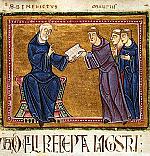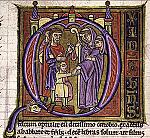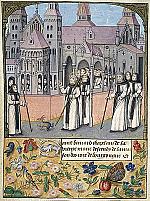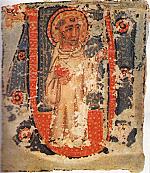Always reviving

[Miniature from a manuscript of De imitatione Christi, showing Thomas a Kempis writing (left) and with a brother (right). Hs. Vienna, Österreichische Nationalbibliothek, Cod. 1576, f. 9r. public domain, Wikimedia File:Imitatione Christi 1576.png]
A revival preacher with a new message appeared—or at least it seemed new to some who felt, whether rightly or wrongly, that their religious practice had become more routine than renewing. His sermons were colloquial and thought-provoking, with dramatic, striking illustrations.
He called his listeners to repentance, and he told them that a closer relationship with God was possible; he criticized religious and sometimes secular leadership. That leadership often responded by condemning him, though some of them were intrigued by his message. Crowds of all kinds gathered to hear his preaching, which cut across social classes, but resonated most with the poor and needy.
Those he had ministered to responded to him with affection, even devotion. He encouraged them to speak and serve even though they were not religious professionals, and they spread the message they had heard to their friends and neighbors. Eventually—for perhaps you will have gathered by now who that revival preacher was—they spread it to most of the known Mediterranean world and eastward in the first century AD.
Rules and the Spirit
But the fact that this description of the earthly ministry of Jesus also describes other, later revivals in the history of the Christian church is no coincidence. From the beginning Christianity presented itself as a reform and a renewal rather than a reinforcement of the status quo.
It was popular and populist—spreading quickly through the Roman and Persian Empires and appealing particularly to less honored groups in both cultures, including women and enslaved people. (Past issues of CH such as #124 and #147 go into more detail about how this happened.—Editors) It was transformative, calling forth conversions from the very first moment Jesus continued the message his cousin John the Baptist was preaching and proclaimed “Repent, for the kingdom of heaven has come near” (Matt. 4:17). While whole books spell out the complex relationship between the followers of the Way and first-century Judaism (see CH #133), Jesus’s message certainly called out some ways in which that institution stood in need of reform. And the call of the Way was devotional, changing hearts as well as minds, calling forth relationships of love not only between believers and their Lord but between believers and each other.
Of course this is only half the story: the early Christian church soon became an institution as well as a movement. Even before the practice of Christianity was legal, it had leaders, it had common worship practices, it had organizational rules, and it had requirements for joining—intended to weed out both frivolous seekers and possible spies. The Didache, dating from the first century, was only the first among a set of church orders—as they came to be called—that helped give structure to the movement of the Spirit.
Legalization in the fourth century hastened this practice of institutionalization, of course—and called forth revival and renewal in response. As the church became more powerful and wealthier, critics of that power and wealth arose, and their messages hearkened back to the early days of the movement. If only we were back in first-century Palestine, reformers thought; if only we could recover the Spirit and the power of those first disciples.
Righteousness or riches?
That critique and that reform expressed itself first and foremost in what came to be known as monasticism. The earliest monks were hermits seeking to transform and question and love in solitude. But almost in spite of themselves, they became popular. People sought them out for advice and prayer. Disciples gathered around them. Communal monasticism came into being.
Once again a renewal movement became an institution. And when people live together—even people who love Jesus very much and are devoted to following him—rules still help. Basil of Caesarea was among the first of those who developed such a rule in Eastern Christianity in the late fourth century; in the West, Benedict of Nursia’s Rule in 597 codified how Christian monastics should live together.
All Benedictine monasteries followed the Rule. In doing so, and in all the small ways in which those monasteries became part of the fabric of life in the towns and villages that grew up around them, they often became rather wealthy, and their abbots and other leaders became powerful advisors to secular rulers and church leaders. Reformers arose to call newly wealthy Benedictines back to the simplicity of the early church. And so the cycle continued.
Monasticism as a marker of true spiritual transformation served as the primary distinguishing feature of the early Middle Ages. Certainly many lay Christians and the parish priests who led them were trying to live Christian lives as best as they knew how.
But from the time that the monastic movement arose, those truly serious about living the Christian life—praying, studying the Scriptures and the lives and writings of earlier saints, repenting, seeking closeness to Christ, serving the community—felt the implicit pressure to become a monk or a nun. Only there, it seemed, could a believer fully follow the “evangelical counsels,” the teachings of Jesus at their most rigorous.
As monasteries grew in wealth and influence, joining one could be a path to power, but it could also be a path to deep faith. And, because the world is complex, sometimes it could be both, as in the career of Pope Gregory I (540–604), whom we most often call Gregory the Great.
Gregory was a Roman aristocrat with the advantages of education and skill who became prefect of Rome in his thirties, yet he also built a monastery on his family estate and joined it. His clear administrative gifts brought him first ordination, then an ambassadorship, then the papacy, all while he kept protesting he would rather be let alone to pray and contemplate. If only we were back in first-century Palestine; if only we could recover the Spirit and the power of those first disciples.
Inspired by the greats
In the early Middle Ages, the saints venerated by the average lay Christian would have been largely monastics (monks and nuns), clergy, and those rulers who were seen as pious and whose acts were seen as society-renewing—such as Charlemagne (747–814) and Alfred the Great (c. 848–899). Such leaders encouraged better education among their subjects—meaning, among other things, that clergy had a better idea of the faith they taught to the laity—and defended Christianity in some way against paganism, heresy, or violence. Sometimes they were even seen as messianic figures (pp. 17–19).
Several things around the turn of the first millennium AD helped transform this bifurcated society—with its clear tension between active and contemplative, secular and sacred, the unrevived and the revived—into one where large numbers of laypeople believed they were called to exercise their baptismal vows, to grow closer to Christ, to be themselves transformed, and to transform the society around them.
The first, which should not be overestimated, came simply from the increasing stability of society in the West in the eleventh and twelfth centuries; the growth of cities, agricultural innovations, a booming economy, more political stability, and more widespread literacy (heir to those earlier educational reforms). It is easier to critique and renew when you are not merely struggling to survive.
Both a cause and an effect of this greater stability, a movement called the Peace and Truce of God soon attempted to limit violence and war. The Peace of God was proclaimed at the Council of Charroux in 987 and the Truce of God at the Council of Toulouges in 1027, but the two movements soon were seen as one.
They attempted to prohibit violence against noncombatants and to limit war and violence only to certain days and seasons. Significantly laypeople led these movements, though clergy were involved. Nobles all the way down to peasants swore to uphold the rules of the Peace of God, not merely as a political move, but as their Christian duty.
Calling out corruption
Onto this stage stepped another Gregory, Gregory VII (c. 1015–1085), born Hildebrand of Sovana and elected pope in 1073. The sweeping church reforms he enacted—called the Gregorian reforms—have often been seen as mainly aimed at strengthening the papacy, which they did (pp. 12–15). Certainly for Protestants looking back across the centuries, his actions seemed the opposite of those that commonly cause revival.
Yet Gregory VII deeply desired to return to the perceived purity of the early church. He called for ridding the church of corruption, and he wanted clergy who took their vows seriously. For Gregory VII this meant above all that they were celibate, did not purchase their offices or take bribes, and were not subject to the whims of (probably) sinful secular leaders. These desires became part of a larger protest against what the church had become. Gregory would not have been happy with the lay movements that arose in his wake claiming that laypeople too could preach and teach, but they were in many ways his heirs. If only we were back in first-century Palestine; if only we could recover the Spirit and the power of those first disciples.
A living sacrifice?
It would be Gregory VII’s next substantive successor, Urban II (1035–1099), assuming the office in 1088 after the short papacy of Victor III, who would spark one of the High Middle Ages’ most significant movements for social transformation and also one of its most controversial and complex—the Crusades.
When Urban responded to Byzantine emperor Alexios I Komnenos’s request for military help against Turkish armies of the Seljuk Empire in 1095, his preaching of what became known as the First Crusade invoked not only political but religious transformation. At least one version of Urban’s speech at the Council of Clermont instigating the First Crusade ends this way:
Whoever, therefore, shall determine upon this holy pilgrimage and shall make his vow to God to that effect and shall offer himself to Him as a living sacrifice, holy, acceptable unto God, shall wear the sign of the cross of the Lord on his forehead or on his breast.
Vast numbers of Western Christians of all social classes, moved by devotional fervor and intent on conversion as well as conquest, responded, and the history of the West—and of the East—was forever changed.
Even as the Crusades raged on—dragged on is probably a better phrase as centuries passed—other movements engulfed numbers of lay Christians seeking a more intense and disciplined spiritual life. The lay saints of twelfth-century Italy, the mendicant movements of the thirteenth century (pp. 28–33), the growth in both mysticism (pp. 34–38—also see CH issue #127) and fervent preaching (pp. 39–42)—all attempted to call people both back to a simpler time and forward to a society-transforming moment that would come if only those revived and renewed could stay the course.
The church hierarchy looked more kindly on some of these lay movements than others, but from the Waldensians (p. 20) to Third Orders that grew up around the mendicant movements to the Beguines to the Brothers and Sisters of the Common Life to the Lollards, laypeople who sought revival were no longer limited to either the choice of a second-class life outside a monastery or departing “the world” to keep the evangelical counsels fully. If only we were back in first-century Palestine; if only we could recover the Spirit and the power of those first disciples.
Revive us again
Many centuries and many revivals later, twentieth-century theologians would popularize the phrase ecclesia reformata semper reformanda—“the church reformed, always reforming,” now a motto of various Presbyterian and Reformed churches. Those who promoted it always claimed it as a more ancient formulation dating back to the time of the Protestant Reformation and perhaps even as far back as Augustine in the fourth century.
Whatever its origins it captures something about not just the Reformed tradition, but the whole Christian story. Over and over again the cycle repeats. The church seems to be growing distant from its vibrant beginning, the last moment of vibrant transformation fading from memory.
Then a new revival preacher appears, or a group of them. Lives are changed, society is altered, and the promise is held out that perhaps this time the kingdom will be ushered in. This time. If only we were back in first-century Palestine; if only we could recover the Spirit and the power of those first disciples. Repent, for the kingdom of heaven has come near. CH
By Jennifer Woodruff Tait
[Christian History originally published this article in Christian History Issue #149 in 2023]
Jennifer Woodruff Tait is managing editor of Christian History and author of several books on church history including Christian History in Seven Sentences. In January 2024 she will become senior editor of CH.Next articles
Countering insult and shame
Pope Gregory VII and the Cistercians tried to reform the church from both above and below
Greg PetersBernard of Clairvaux’s labor of love
Mentor to popes, advisor to royals, arbiter of heresies, and author for the ages
Paul RoremLooking for the last emperor
Some medieval thinkers and writers sought reform because they thought the end was coming
Randolph DanielSupport us
Christian History Institute (CHI) is a non-profit Pennsylvania corporation founded in 1982. Your donations support the continuation of this ministry
Donate







